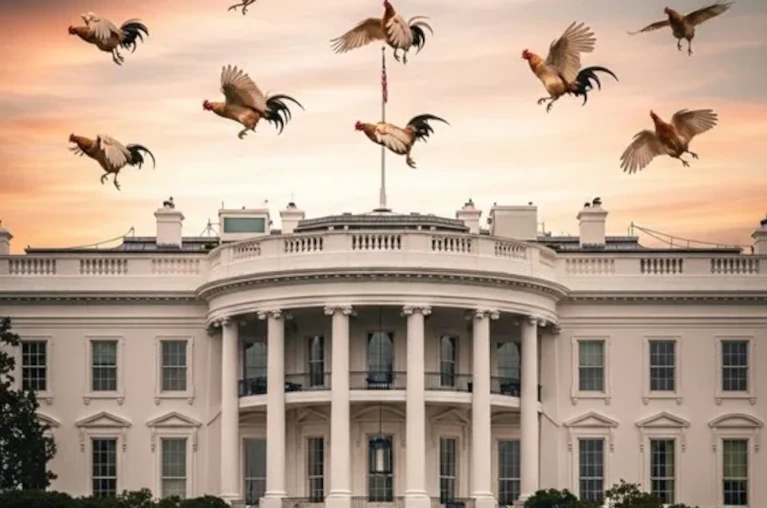
Venice has its pigeons and Capistrano its swallows. Flying over the White House and Capitol Hill these days are birds of a different feather – chickens. For the president and the GOP Congress, they’ll soon be coming home to roost.
Although all elections are important, some are more so than others. History will look back on the 2026 midterms as among the most momentous of the modern era. The reason for this can be summed up in three simple words: Donald John Trump.
The president so dominates the executive and legislative branches that the 2026 elections will be a referendum on his handling of the economy and the affairs of state. Trump claims to have won a popular mandate at the polls last November. It’s FAKE News.
Trump’s winning margin in 2024 was less than 1.5 percent of the popular vote. Although beating Harris by 16 percent in the Electoral College vote, it’s a flawed number in that it fails to reflect popular sentiment and how evenly divided the nation seems to be. The narrow majorities in both the House and Senate are further proof that America is split nearly in half between Trump supporters and everyone else.
If presidential elections are examples of regime change, then the electionof Donald J. Trump in 2024 is an example of radical culture change.
Trump doesn’t have a popular mandate. He has a license given him by the Republicans in Congress and the conservatives on the Supreme Court to do almost anything he wants. The Republican Senate has rubber-stamped its approval of what many believe to be the least competent and most ethically compromised cabinet since the Harding administration.
The House fiddles while the president impounds the monies Congress appropriates, guts agencies established by law, and stops projects that have attracted billions of dollars of private investment because he thinks wind turbines are ugly and coal “clean” and “beautiful”. (What if we were to gold plate the wind turbines, Mr. President?)
Without understanding what was actually being done, the Republicans in Congress hailed Elon Musk and his chainsaw for cutting government programs they oversee and are responsible for, because they contained words like climate, clean energy, environment, minority, vaccine, scientific or medical research, equity, and justice.
Government reform by a keyword search has predictably resulted in major gaps in the operation of federal agencies and the implementation of various programs and policies. Because weather and climate change are closely connected, the Department of Government Efficiency (DOGE) cut critical forecasting work. It suspended tracking programs at the National Weather Service (NWS) and the National Oceanic and Atmospheric Administration (NOAA).
What does it say when an administration fires the independent inspectors general of nearly every cabinet department and doesn’t replace them? What does it tell you about the relationship of an administration to the truth when the government attempts to overwrite history to conform to nationalistic myths or censors and removes scientific information from federal websites because it conflicts with the fancies of the president?
The first nine months of Trump’s 2nd regime have turned the federal government feral.
The Department of Justice attacks any individual, group, or institution that deigns to disagree with the president and his worldview. Not to put too fine a point on it, but Trump has been able to wing his way out of most problems by crying FAKE NEWS, using misdirection, firing the messenger, or threatening to use the full might of the federal government to prosecute an opponent.
The consequences of Trumpian economics and government reforms are just now showing up in the economy. Given all that’s happened over the past eight months, it’s easy to forget that the impacts of many of Trump’s policy and program reforms, tariffs, and deportation programs are in the earliest stages of implementation.
Delays between implementation and impact are the result of various factors. In the case of rising prices, pre-tariff inventories and efforts by companies to “eat” the new import costs for as long as possible have tamped down pricing. However, companies are running out of options.
At some point, the truth catches up to all of us – Mr. Trump included.
A July survey by KPMG found that “83 percent of businesses expect to raise prices in the next six months, with nearly three quarters already passing on some of the costs.” According to the company: “The full impact on consumers is likely still to come.”
Two of Trump’s most vaunted accomplishments – tariffs and the “One Big Beautiful Bill” (OBBB) are among the reasons the president’s approval ratings are trending south. According to the Pew Research Center, 61 percent of Americans disapprove of Trump’s tariff policies, while 38 percent approve. The disapproval number for OBBB is 46 percent, while 32 percent approve, with 23 percent being unsure. (See Figure 1)
A Washington Post/IPSOS poll released on September 18th confirmed Pew’s earlier findings. Trump’s approval within Republican ranks was also shown to be dropping, especially among “younger Republican and GOP women.”
What could also prove problematic for Republicans in the 2026 congressional elections is the view of a majority of adult Americans (53 percent) that Trump “is making the federal government work worse, while only about half as many (27 percent) say he is making government better.” The numbers reflect lessening support for Trump’s handling of the federal bureaucracy.
Trump is underwater in terms of voter approval, even for his handling of immigration and crime. Both are issues he has traditionally scored high on. Although the surveys show predictable partisan splits, the loss of favorability amongst independent voters could prove the difference in 2026.
Trump’s response to the poll numbers is – as it always is – to blame the polls and the bias of organizations responsible for them. The president spares no one. In a recent interview on FOX News with Martha McCallum, he blamed FOX for bad polling.
There’s going to come a time when claims of FAKE NEWS and disingenuous pollsters will not outweigh the truth of weakening job markets, rising prices, and dysfunctional federal agencies.
The reasons behind Trump’s loss of support are real rather than theoretical. If younger Republicans lose faith in the president’s economic policies, it’s because recent graduates are being hit hardest by the softening labor market.
China’s reduced imports of US farm products are negatively impacting the nation’s agricultural economy. Not only are farmers unable to sell their soybeans, but they aren’t buying new combines, harvesters, and tractors. The loss of low-wage immigrant labor to harvest crops and pack meat means a rise in food prices.
Mr. Trump could fire every government statistician and replace them with MAGA acolytes, and it wouldn’t change the reality of rising prices and the increasing concerns of voters. Trump’s rebrand of his OBBB as the Working Families Tax Cut is unlikely to take voters’ minds off the fact that their dollar is buying less than it did a month ago, or that they’re paying more for health insurance, when they can afford it at all.
Trump and the GOP have other reasons to be anxious over the potential outcome of the 2026 elections. Historically, midterm elections are notoriously brutal to a sitting president’s party.
Known as the midterm curse, the party controlling the White House has lost an average of 28 seats in the House of Representatives and four seats in the Senate over the 22 off-year elections between 1934 and 2018. (The 2022 midterms did not follow the law of averages as the Democrats lost just six seats in the House while gaining one in the Senate.)
The generic congressional ballot shows Democrats with a lead over Republicans of between three and eight percent, indicating that partisanship is still a major factor in how Americans are likely to vote in 2026. The 2018 generic ballot showed a spread in favor of the Democrats of between seven and 13 percentage points.
The 2018 elections resulted in “a net total of 41 seats from the total number of seats they had won in the 2016 elections.” It was the Democrats’ “largest gain of House seats since the post-Watergate 1974 elections, when they picked up 49 seats.” Trump’s approval ratings at the time hovered around 50 percent.
Even factoring in red-state redistricting, the current numbers suggest that the Democrats have a reasonable chance of taking control of the House after the 2026 elections. The likelihood that the Dems will gain the net of four seats needed to flip the Senate is less.
If the overwhelming majority of economists and political analysts are right, the negative consequences of the president’s policies will only worsen between now and November 2026. If the past is prologue, then the midterm elections will return control of the House to Democrats. From an environmental perspective, Democratic control of the House is a net good thing.
Trump’s opposition to clean energy sources and environmental regulation is so virulent that it’s resulting in the administration working against itself. The Inflation Reduction Act (IRA) has leveraged billions of dollars of private investments in red states – ironically, more in red than blue. One example is the recently raided, under-construction Hyundai battery plant in Georgia.
The White House has rebuffed efforts of red state Republicans to continue the programs. GOP proponents have partly argued that the administration could take credit for it. Trump had no problem taking credit for infrastructure projects contracted for by the Biden administration. Why not for the IRA? (I’ll have more to say about this in Part 2 of “A Government Most Fowl” as it concerns messaging.)
Nothing is more critical in terms of federal climate policy than slowing the administration’s cancellation of renewable energy programs and the unwinding of environmental regulations back to a time before Nixon.
The 2026 midterm elections are an opportunity to effectively slow the Trump administration’s onslaught against clean energy and the environment. In the run-up to the election, the clean energy and environmental communities must keep their collective eyes on the prize – a Democratic House majority.
If I were asked to suggest a phrase that best describes what the midterm election will be about, I’d put “back to basics” at the top of my list. Even in good times, elections are about the economy.
Contrary to what Trump says and demands his administration agree with, people are worried about inflation, jobs, and whether tariffs are worth their sacrifice. Seeing your utility bill go up five percent or more in a month isn’t FAKE NEWS. It’s a problem for the average family of four.
Part of people’s core concern is whether the government will be there for them in times of emergency – personal or societal. A majority of voters believe Trump isn’t the problem solver he claims to be. In fact, they’ll soon be wondering if he isn’t the problem giver.
Voters in 2026 are going to be looking for answers to bread-and-butter issues. It will be up to the clean energy and environmental communities to help frame the debate in a manner that resonates with voters, particularly independents and conservative youth and builds a foundation for the 2028 elections.
In Part 2 of “A Government Most Fowl”, I’ll discuss how the midterms run-up should be used to reset the clean energy and environment debates in response to today’s political realities. One is that Trump has set the terms of the debate, which means keeping it simple and less philosophical.
Lead image credit: J. Stronberg and AI



